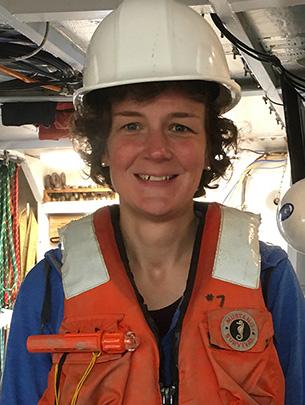If you swallow a drop of water from Lake Michigan, it will contain roughly a million bacterial cells and 10 million bacteriophages—tiny viruses that infect bacteria and may outnumber every other organism on Earth.
“There’s a lot of interest lately in the human microbiome,” said Coleman, an assistant professor in the University of Chicago’s Department of the Geophysical Sciences. “But lakes also have a microbiome.”
Luckily for Coleman, whose lab studies how communities of microbes adapt, interact and coevolve, nearby Lake Michigan and the Great Lakes are excellent model systems for studying bacteria and their hangers-on.

When she arrived on campus in 2012, Coleman was surprised to learn that no one had yet systematically researched the microbiome of the Great Lakes. So for the past eight summers, she and her team have done just that, in collaboration with the Environmental Protection Agency. (The EPA has tracked water quality and some multicellular organisms in the lakes since 1983, but its research had not included the systematic sampling of bacteria, archaea and viruses.)
A forthcoming paper in the journal Environmental Microbiology details some results of the lab’s groundbreaking work completing the first microbial time series—an innovative comparison of populations in water samples drawn from the same sites over time—that covers all five Great Lakes.
Why dip your toes into such an ambitious research program? Because microbes perform a number of vital ecological functions. For one, Coleman said, they process all of the runoff from land, including “all of the fertilizer, all of the pesticides, all of the pollution from Chicago—although not our sewage because we send that down the river.” They are also fundamental to the food web. “If you’re interested in fisheries, for instance, you need to care about what’s happening at the very bottom of the food web as well.”
The Great Lakes “each have their own unique character—Lake Erie is really, really different from Lake Superior—and yet at the same time, they’re connected,” Coleman said. While this makes them a theoretically interesting system, the lakes are also inherently valuable, supplying a staggering 20 percent of the world’s liquid fresh water. Keeping this precious, sought-after resource in good shape is, in large part, a matter of following the microbial signals.
A ‘desire to solve problems’
Real-world challenges such as these are what motivate Coleman, whose received her PhD from MIT in civil and environmental engineering. “I am in no way qualified to build a bridge or anything,” she said. “But I do still carry with me that desire to solve problems, as opposed to just studying basic science for the pure love of theory and fundamentals.”
Coleman describes fieldwork and lab work as complementary: Discoveries in the wild can inspire hypotheses that you test back home. In the lab, Coleman’s team uses a technique called transposon sequencing to knock out genes from microbes and observe the resulting functional differences.
“With this approach, you can do global-scale gene deletions and then test the functions of all of these genes essentially in parallel.” Such experiments are in demand: Scientists have gotten so good at discovering microbial genes that thousands more have been identified than are well understood.
The scope of the unknown in microbiology is a familiar and humbling fact to Coleman. Her PhD research was on the photosynthetic cyanobacterium Prochlorococcus—an organism that, despite being among the most abundant bacteria on Earth, was not discovered until 1986, by a team including Coleman’s adviser Sallie “Penny” W. Chisholm. Today’s sequencing technology, Coleman said, “gives us a new tool to figure out how much we don’t know.”

